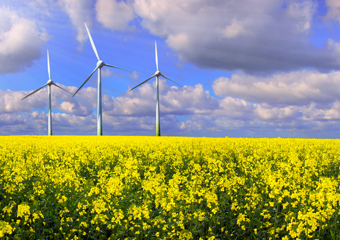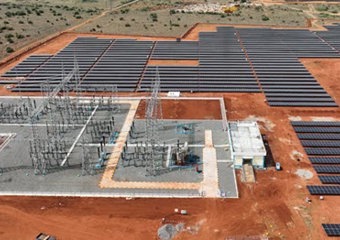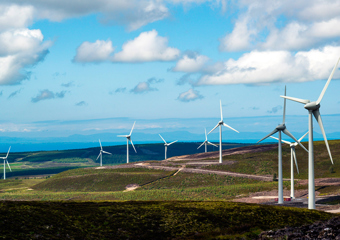
The potentials for solar power are great in the sunny parts of India, not only in the form of smaller, distributed solar cell plants in the countryside, but also in the form of large solar power parks. The picture is from such a large solar power park near Raichur in India.
Country series: India's future is renewable
India has large coal reserves and will need coal as an energy source for decades. Fortunately, the country also has 300 sunny days a year. If India is to achieve its climate goals, it is crucial that growth in energy production come from renewable sources.
India has low greenhouse gas emissions per capita, but because the country is so populous, it has the third-highest total emissions in the world, surpassed only by China and the United States. What India is doing to curb climate emissions is important not only for the country itself, but also for global climate goals.
With a rapidly growing population and a long-awaited improvement in living standards, energy demand in India will increase sharply in the coming years. The big question is how will this energy be produced in the future: with even more coal or with renewable energy?

Rahul Varshney is Statkraft's country manager in India, based in the country's capital New Delhi.

Facts about India
-
Population: 1.3 billion
-
Capital: New Delhi
-
System of government: Federal parliamentary constitutional republic
-
President: Ram Nath Kovind
-
Prime Minister: Narendra Modi
-
Language: Hindi and English, and 22 official regional languages
New climate goals
At the UN climate conference COP26 in Glasgow in 2021, Indian prime minister Narendra Modi presented new and more ambitious climate goals. He said that India would increase its renewable energy production to 500 gigawatts and thus meet the requirement that 50 per cent of energy needs would be met by renewable energy by 2030.
India will also reduce its total CO2 emissions by one billion tonnes by 2030. While many industrialised countries have stated that they will reach the goal of net zero emissions by 2050, India has said that it will not reach this goal until 2070, the same as China.
Coal still important
According to the International Energy Agency (IEA), 80 per cent of India's energy needs today are met by coal, oil and solid fuels. Coal has made it possible to increase power production and develop industry, and coal is still the largest and most important source of energy. Oil consumption and oil imports have grown rapidly because more and more Indians are buying cars and because road transport is increasing.

"Making the energy sector greener is important for India, but the availability of affordable and reliable energy is a challenge in itself," points out Statkraft's country manager in India, Rahul Varshney.
"India has large coal reserves, and many of the coal power plants are relatively new. They are efficient, ensure a secure energy supply and make India less dependent on imported oil and gas. This makes it challenging to phase out coal."
Increase in renewable energy
Growth in coal power however has levelled off, and new energy production comes mainly from renewable sources such as wind and solar. As wind and solar power are becoming increasingly affordable to develop, growth in renewable energy is not primarily driven by a desire to make India "greener". Renewable energy is being developed because it pays off.
The costs of energy development are crucial. India is an emerging economy, and people have more fundamental challenges in their daily lives than worrying about global climate issues. Most Indians will not be willing to pay a higher price for renewable energy just because it is "clean", but as long as clean solar energy is cheap at the same time, there will be no discussion.

Solar investments
At the beginning of 2022, Statkraft has one solar energy project under construction and several more under development in India. The potential for solar energy is immense in India, the country's ambitions are high, and political support and cheaper technology have quickly made solar energy the best option for new power production.
Recent IEA analyses show that India already in 2018 invested more in solar energy than in all fossil sources combined.
"In Statkraft we have changed our solar strategy for India. We have moved away from investing in smaller, distributed solar energy companies and toward developing large projects instead. We will continue to look for more investment opportunities because we want to be a positive contributor to India's power sector," says Varshney.

Nellai solar power plant is located in an area of India with normally 300 days of sunshine a year.
Nellai, Statkraft's first large-scale solar park in India
Statkraft has commissioned the Nellai solar power plant near the village of Ettanakulam in the state of Tamil Nadu in India. The area where the solar power plant is built normally has around 300 sunny days a year. The solar power plant has a total capacity of 76 MWp and is estimated to generate about 124 GWh annually. The project is Statkraft's first large-scale solar power plant in India.
Pollution is a problem in India
Another driver of the green shift in India is the extreme air pollution, especially in the major cities. Eleven of the world's twelve most polluted cities are in India. This has many and complex causes, but the coal industry is one factor, along with emissions from the transport and construction sectors.
As more and more Indians are lifted out of poverty, the population and greenhouse gas emissions increase. Greater awareness of the pollution problem has also helped strengthen the focus on emission cuts and cleaner air. The green shift is no longer a matter of choice, but rather necessity.
Electrification helps to reduce pollution from households traditionally using wood as fuel. In April 2018, India's prime minister Narendra Modi announced that all villages in India had been connected to the power grid. Since 2000, half a billion people have gained access to electricity. The International Energy Agency characterises this development as an unparalleled historic achievement.
But power consumption is still modest. Every single Indian uses only about 1 200 kWh a year. In comparison, the average consumption in China is between 5,000 and 6,000 kWh, and more than 10,000 kWh in industrialised countries.
In recent years, India has lifted millions of people out of extreme poverty, and this positive trend is expected to continue. India's electricity consumption is likely to grow rapidly due to population growth, rising living standards and further electrification.

Enormous potential
"The potential for renewable energy is enormous in India, and this is a great opportunity for Statkraft. Statkraft has a strong position as a developer of renewable energy in Europe, and we aim to take a strong position in the Indian market as well," says Vikas Garg, head of business and project development in Statkraft India.
Statkraft is not the only company that sees great opportunities in India, but the company has some competitive advantages: long experience with renewable energy sources, a strong financial position and expertise in power trading. This means that customers perceive Statkraft as a reliable and safe company.
Statkraft's expertise in energy management can also be valuable in India, where the integration of variable power sources in the grid is becoming increasingly important as the share of renewable energy increases.
Dramatic climate consequences
India has a strong self-interest in helping to find good solutions to global climate problems. Reports from the UN Intergovernmental Panel om Climate Change show that the consequences of global warming affect countries differently, and India is one of the countries most likely to be negatively impacted by droughts, heat waves and rising sea levels. This can lead to insecure food supply, high food prices, migration and reduced income.
However, it is obvious that the solution to the climate crisis cannot be to stunt the growth of living standards for poor people. The only answer is to ensure that economic growth and increased prosperity are driven by affordable renewable energy accessible to everyone.





Statkraft in India
Statkraft entered the Indian market in 2004 and was the first foreign company to invest in the country's hydropower sector.
In 2018, the company acquired the Tidong hydropower project. When completed, it will produce 414 GWh annually, which corresponds to the consumption of 345,000 Indians.
Statkraft owns 49 per cent of the run-of-river power plant Malana Hydro Electric Power with an annual production of 370 GWh, and 43 per cent of the run-of-river power plant Allain Duhangan with an annual production of 700 GWh.
Statkraft has solar energy projects totalling 150 MW in development and under construction in India and wants to develop more wind and solar power in the country.
Statkraft Markets was established in India in 2012 and engages in power trading for both Statkraft and third-party customers.

The potential for renewable energy is enormous in India, and this is a great opportunity for Statkraft.
Other country series articles

Country series: German energy revolution
2017 marked the first year when more power was produced from renewable sources than from coal in the industrial giant Germany. Nuclear power and coal power will be phased out over the next few years,...
Read more

Country series: Sweden global leader in reducing climate impact
Few countries in the world use more energy per capita than Sweden. Nevertheless, its greenhouse gas emissions are low, thanks to renewables generating a large part of the power consumed. The homeland...
Read more

Country series: Albania's hydropower important for the Balkans
Albania can play a key role when the Balkan countries phase out fossil fuels in favour of renewables. Statkraft already operates in Albania, but political risk can put a damper on further growth.
Read more

Country series: Ireland with an ambitious climate action plan
About 40 per cent of Ireland's electricity currently comes from renewable sources, but the country aims to increase this to 70 per cent by 2030.
Read more

Country series: Green ambitions in Spain
Renewable sources accounted for almost 47 per cent of the electricity produced in Spain in 2021. This is the highest share of renewable electricity since measurements began, but short of the Spanish...
Read more

Country series: India's future is renewable
India has large coal reserves and will need coal as an energy source for decades. Fortunately, the country also has 300 sunny days a year. If India is to achieve its climate goals, it is crucial that...
Read more

Country series: Resource wealth in Brazil
Brazil is blessed with a wealth of natural resources and one of the world's cleanest power supplies. Large-scale investment in solar and wind power will provide even more renewable power in the years...
Read more

Country series: Ireland with an ambitious climate action plan
About 40 per cent of Ireland's electricity currently comes from renewable sources, but the country aims to increase this to 70 per cent by 2030.
Read more

Country series: United Kingdom, a leader in ambition
The United Kingdom has major ambitions for cutting its greenhouse gas emissions. The goal is to become a zero-emission society by 2050. Getting there will be a taxing process and requires strong poli...
Read more

Country series: Faster progress on renewables in Italy?
With its long coastline, high mountains and sunny Mediterranean islands, Italy should be well placed to increase its production of renewable energy. The challenge is to link power production with co...
Read more

Country series: The United States is still a land of opportunity
Since Statkraft opened an office in the U.S. in 2015, the company's U.S. operations have revolved largely around trading in CO2 allowances and renewable energy certificates. Statkraft is now well posi...
Read more

Country series: Renewables grow fast in Poland
Poland is one of the largest countries in Europe both in terms of energy consumption and energy production, and coal is still the main energy source. At the same time, Poland has the fastest growing...
Read more

Country series: Green visions in France
Nuclear power nation France faces massive changes in the energy sector in the years to come. An ambitious commitment to wind and solar power is one of the measures that will ensure that the climate ...
Read more

Country series: Chile leads the way with commitment to renewable energy
Chile has ambitious climate targets: 70 per cent of the country's electricity will come from renewable sources by 2030, and the country will be carbon neutral by 2050.
Read more

Country series: The Netherlands needs a strong commitment to renewable energy
The Netherlands' actual cuts in greenhouse gas emissions have been small in recent decades. When the government lost a climate change lawsuit, it forced a new national climate agreement that should ge...
Read more

Country series: Sun rising for Croatia
With its sunny Mediterranean coast, Croatia is one of Europe's fastest-growing markets for solar power. By utilising its renewable energy potential, the country can eliminate electricity imports.
Read more